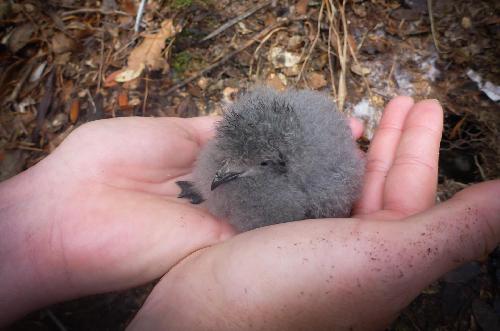Continued investment in invasive mammal eradications on islands offers a highly effective opportunity to stem the loss of our world's biodiversity. So concludes a 30-member team of scientists conducting the first ever global study quantifying benefits of this conservation intervention.
The study, titled "Invasive mammal eradication on islands results in substantial conservation gains," examined how native species responded to projects that eradicated invasive mammals from islands. The researchers found 596 populations of 236 native species on 181 islands benefitted from these eradications. The study is scheduled for publication the week of March 21, 2016 in the online Early Edition of the journal, Proceedings of the National Academy of Sciences.
"We've known that invasive mammal eradications are a powerful conservation tool, but this is the first time the benefits have been quantified at the global scale," said lead author Holly Jones, assistant professor in biological sciences and the Institute for the Study of the Environment, Sustainability, and Energy at Northern Illinois University. "Twenty one billion dollars (US) are spent globally each year on nature conservation. A small fraction of this goes to eradication of invasive species, yet this relatively simple, cost-effective conservation intervention is benefitting hundreds of native animals and endangered species. This is fantastic news in the race to prevent extinctions."
 Once thought extinct, New Zealand storm-petrels were rediscovered breeding on Little Barrier/Hauturu-o-toi following cat and rat eradication. Credit: Stephanie B. Borrelle
Once thought extinct, New Zealand storm-petrels were rediscovered breeding on Little Barrier/Hauturu-o-toi following cat and rat eradication. Credit: Stephanie B. Borrelle
"These island restoration projects are a proverbial silver bullet for biodiversity conservation," said co-author Nick Holmes, director of science for Island Conservation, a non-profit organization with a mission to prevent extinctions by removing invasive species from islands. "For any conservation intervention, it is rare to find a body of global evidence measuring the outcomes for native species. These results are a testament to the value of these types of projects and the practitioners advancing them around our world."
The research team conducted a large-scale literature and database review along with expert interviews to estimate the benefits to native species of removing invasive mammals found on islands. The researchers documented positive responses, including population increases, recolonization and successful reintroductions. Four species that qualified for down-listing to a lower category of extinction risk on the IUCN Red List, in part due to invasive mammal eradication, were the Island fox (California), Seychelles magpie robin (Seychelles), Cook's petrel (New Zealand) and Black-vented shearwater (Mexico).
Once introduced to islands, invasive mammals -- primarily rodents, feral goats and feral cats -- represent key threats to native species through predation, competition and habitat loss.
"Humans have introduced non-native, invasive mammals (accidentally or intentionally) to 90 percent of the world's island archipelagos," said co-author Don Croll, a biology professor at the University of California Santa Cruz. "These mammals have devastating consequences for ecosystems because island species evolved in isolation without these mammalian predators. They have little to no defense against invasive mammals."
Islands with invasive species pose a unique biodiversity conservation challenge and opportunity. Islands occupy less than 6 percent of Earth's land area, yet are home to 15 percent of terrestrial species. Islands represent 61 percent of recorded extinctions with invasive species implicated in the majority of those. Thirty-seven percent of all Critically Endangered Species on the IUCN Red List are found on islands.
"Invasive alien species are causing an extinction crisis on the world's islands, but our research shows that this is one problem for which we have the tools to tackle, and the results can be spectacularly successful," said co-author Stuart Butchart, head of science at BirdLife International, the world's largest partnership of nature conservation organizations.
The researchers' noted examples of responses included: The New Zealand storm-petrel, thought extinct for more than 150 years, was recently found breeding on Little Barrier Island following cat and rat eradication. The Scripps' murrelet is no longer a candidate for listing on the U.S. Endangered Species Act following rat eradication on Anacapa Island. The California Channel Islands' endemic Island fox has been proposed to be removed from the Endangered Species Act following intensive conservation efforts, including a feral pig eradication on Santa Cruz Island.
Documented beneficiaries of invasive mammal eradications are likely underreported because of a lack of monitoring, the researchers added.
Biologists have long been aware of the damage that can be done at the hands of invasive species. In February 1894, in New Zealand, one of the Stephens Island lighthouse keepers' pregnant house cats escaped, went feral, and the population rocketed. By March 1895, cats were largely responsible for driving the Stephens Island wren to extinction. On the Pacific Ocean's Kiritimati Island, cats and rats wiped out the Christmas sandpiper in the late 1800s. Cats on Guadalupe Island, Mexico, drove the Guadalupe storm-petrel to extinction in the early 1900s. There are hundreds more stories like this.
In recent decades, eradication programs have gained traction even on more populated islands. More than 1,100 attempts at eradication of invasive mammal populations have occurred. "Many eradication techniques were first developed in New Zealand, so much so that it's been commonplace to 'call the Kiwis' if you want to eradicate mammals," Jones said. "Now, more and more conservation organizations worldwide are embracing this conservation intervention."
Jones hopes the study's results will help conservation practitioners see where they can make further strides to curb extinctions and protect native species. "While we can't bring back the species that have gone extinct, our analysis shows that removing invasive mammals can help us undo some of the damage we've caused," she said.
source: Northern Illinois University